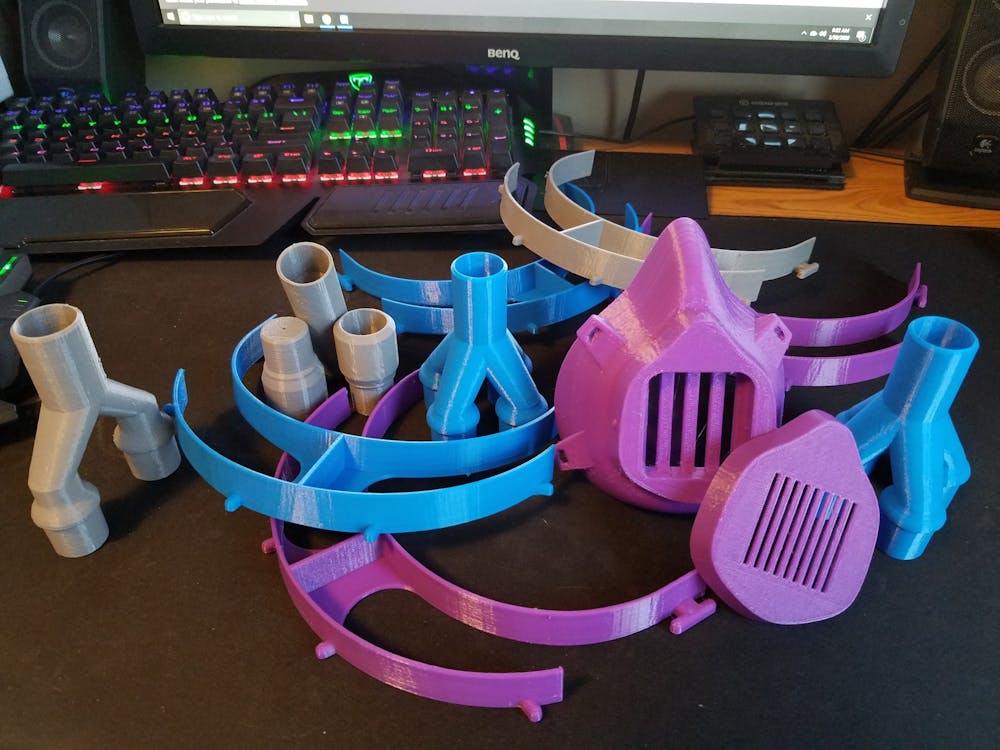He was used to making models of fossils for the geology department, “World’s Greatest Dad” tokens, even a 10-inch span of intestine. But IU’s 3D lab coordinator Andrew Webb never thought he’d be 3D printing masks to fight a global pandemic.
“Never in my wildest dreams,” he said. “I was perfectly content printing trinkets and toys.”
Webb is part of a legion of engineers, scientists and health care professionals turning to 3D printing to address the dire need for masks to combat the spread of the coronavirus.
Universities across the country are deploying 3D printers for masks, including at University of Kentucky HealthCare, the Medical University of South Carolina and University of Wyoming. Teams at Florida International University, Columbia University, the University of Texas at Austin, Cornell University, University of North Carolina Charlotte and Stony Brook University are 3D printing face shields, while folks at University of Illinois at Chicago’s makerspace and North Carolina State University’s engineering department are using laser cutters to make protective shields. Even Nike is prototyping face shields with the help of Oregon Health & Science University.
But creating the blueprint for these masks is not a simple task, and ensuring the masks have proper ventilation and filtration is a long process.
After IU Health contacted him about 3D printing masks, Webb, 27, hauled home five 3D printers from Herman B Wells Library at IU, rushing to grab them before the library's doors shuttered. He loaded each 50-pound printer onto a mailroom cart, heaved them into a van, took them home and set them up in his front room.
Now, he’s trying different pieces together, testing for ventilation and waiting for critical needs assessments. In a Slack group, engineers with 3D printers at universities around the country critique prototypes and chat about design specifications until 2:30 a.m.
“It never stops,” Webb said. “People are working around the clock on this.”
Webb has produced a couple bags of prototypes himself, but he knows others from IU Health, IU, Ivy Tech, Duke University and more are collaborating and building their own piles of prototypes.
Webb is experimenting with Y and X splitters, valves that divide airflow for ventilators, potentially allowing two or three people to use a single ventilator rather than just one. He’s printing screw knobs that IU Health researchers are testing as a way to restrict airflow. One researcher shows how different 3D printed parts affect the inflation of prosthetic lungs by sending the occasional video in the Slack.
The designers are trying to build the masks in pieces that lock together so that health care workers can split the parts, sterilize each one, replace the filter and reassemble. But since the 3D printers aren’t medical grade, they’ve had to be creative. The masks, for instance, won’t naturally create a tight seal around the face, so Webb is adding rubber gaskets.
IU Health researchers are gathering data on which models are most effective. And while collecting data usually takes time, a global pandemic can speed things up exponentially. Webb expects researchers working around-the-clock will have enough data to move forward any day now.
Once models are approved, Webb expects each mask to take around seven hours to make. He said he should churn out about 50 for IU Health in a week.
Adam Maltese, an associate professor at IU and director of the MILL Makerspace in the School of Education, decided making masks may not be in his wheelhouse.
He has noticed crafty seamstresses across the country mining their stashes for leftover bits of fabric to sew homemade masks, but he has reservations about masks that don’t undergo the rigorous testing that Webb’s 3D printed masks will.
Instead, he realized there may be more need for face shields — plastic, transparent masks used by many front-line workers in addition to N95 masks. Once he got word that the IU Health Center was in need of more face shields, he got to work.
With a face shield sent by the health center as a model, Maltese scoured his workshop for materials. He and a friend pulled out a thick, red, transparent sheet of acrylic, cut it into shape and added straps.
“That’s when we were like ‘Oh, OK this can work,'” he said.
Then he tried to improve it. Maltese swapped his red acrylic for a thinner, non-colored plastic. He cut out pieces with a laser cutter, sliced holes for straps and used a heat gun to mold the sheet into a curve. Later, he switched to a T-shirt press that worked better on broad surfaces. He cut buckles and added foam cushioning. He added elastic webbing to the straps.
He joked with a friend who was helping him that they were making artisanal, handmade masks.
“The design is quite simple,” he said. “And we were able to do everything in-house.”
Now the IU Health Center wants some on reserve. They may hand off some face shields to IUPD as well. But Maltese is hoping current supplies of face shields suffice and his are never used.
“But if they need to be used, we feel good about our design.”
But these efforts go beyond just addressing the current shortage, Webb said. The countless hours prototyping and testing masks and face shields means that if anything like the COVID-19 pandemic happens again, the health care system will have more data and smoother processes in place.
“Everything we do now is just another stepping stone for the future,” he said. “The next time anything like this comes around, we’ll be ready.”




